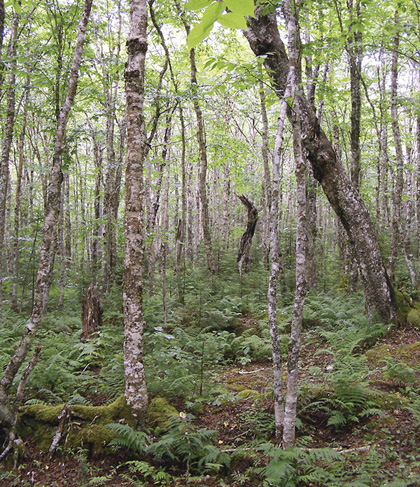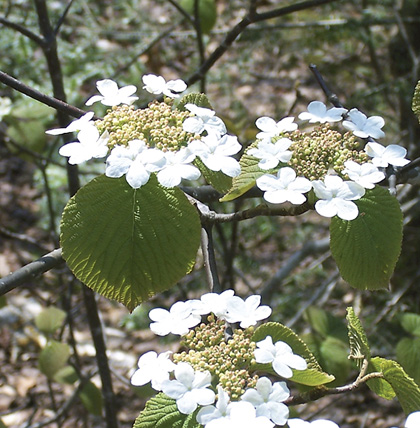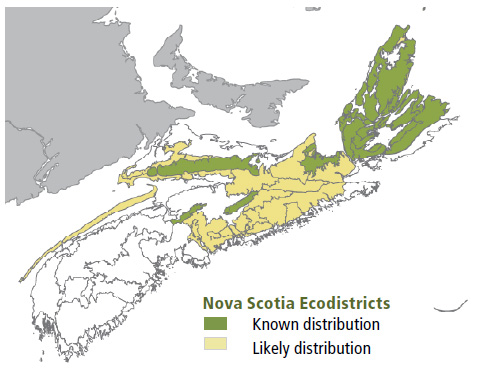
Forest Vegetation types - TH7
TH7 — Yellow birch – White birch / Evergreen wood fern
Betula alleghaniensis – Betula papyrifera / Dryopteris intermedia
 |
Hornes Road, Cape Breton County |
Concept: This mid-successional Vegetation Types VT has an overstory dominated by yellow birch with a strong component of white birch. Balsam fir is also common in both the overstory and understory – its dominance in either layer reflects the time elapsed since the last major insect disturbance (spruce budworm or tussock moth). Yellow birch – White birch / Evergreen wood fern is mainly found in the eastern Nova Scotia.
Vegetation: Yellow birch and white birch are the dominant overstory trees, with lesser amounts of balsam fir, red maple and white spruce. Scattered sugar maple, red spruce and beech are also typical. Balsam fir, and sometimes red maple, is prominent in the shrub layer with red maple also common in some stands. The herb layer has extensive fern cover including wood ferns, hay-scented fern, northern beech fern, bracken and New York fern. Other common plants include wild lily-of-the-valley, bunchberry, wood sorrel, sarsaparilla and gold thread. The bryophyte later is discontinuous and species-poor, especially where the forest floor is characterized by leaf litter and/or where the softwood component is low.
Environmental Setting: TH7 is mainly associated with fresh, nutrient medium soils of glacial origin. This VT is primarily found in eastern Nova Scotia and Cape Breton. TH7 is similar but ecologically distinct from HL4 (Birch / Wood fern – Wood sorrel), a transition forest occurring on upper slopes adjacent to the Cape Breton Highlands plateau. It is common in New Brunswick but rare on Prince Edward Island.
Successional Dynamics: TH7 is a mid-successional hardwood VT that follows partial stand-level disturbance in mixedwood forests such as MW1 (Red spruce – Yellow birch / Evergreen wood fern), MW4 (Balsam fir – Red maple / Wood sorrel – Goldthread) and MW5 (White birch – Balsam fir / Sarsaparilla – Bracken). The softwood component in these mixedwood stands has been removed either by harvesting or insect/disease. TH7 may also originate after partial harvesting in TH1 (Sugar maple / Hay-scented fern), TH2 (Sugar maple / New York fern – Northern beech fern) and IH7 (Red maple / Hay-scented fern – Wood sorrel) stands.
Ecological Features: This closed canopy hardwood forest frequently occurs in small patches, most of which are inclusions within broader hardwood matrix forest. Yellow birch's longevity and intermediate shade tolerance facilitates the development of uneven-aged canopy structures particularly as white birch trees are eliminated through natural mortality. Yellow birch can produce stems more than 25 meters tall with diameters of up to 100 cm, and it has the ability to withstand severe crown breakage and rotting. Large diameter, living, hollow trees are common in this forest type and provide good denning sites, cavity nest sites for songbirds, and nest sites for broad-winged hawks and northern goshawks. Downed coarse woody debris may provide cover for red-backed salamanders and small mammals. Birch seeds and catkins are an abundant food source during the winter for many species of birds (e.g. ruffed grouse) and small mammals. Birch trees may be deformed by birch cinder conch, a fungal growth occasionally harvested for Chaga tea.
 |
| Hobble-bush |
Distinguishing Features: This hardwood forest is dominated by yellow and white birch with only a scattering of other hardwood species. Balsam fir can be abundant in both the canopy and understory layers. It is primarily found in eastern Nova Scotia. Several species of ferns create extensive ground cover.
| Slope Position: | Upper6 Middle4 |
Surface Stoniness: |
(Moderately)5 (Non - Slightly)4 (Very - Excessively)1 |
Bedrock Outcrop: |
(Non-rocky)7 (Slightly - Moderately)3 |
Elevation Range: |
51 - 336m |
Slope Gradient: |
Gentle7 Moderate2 Steep1 |
Aspect: |
North4 East1 West5 |
Exposure: |
Exposed4 Mod. exposed4 Moderate2 |
Microtopography: |
Moderately8 Severely1 Slightly1 |
Drainage: |
Moderately well6 Well3 Rapid1 |
Soil Type: |
ST2-L6 ST22 ST151 nd1 |
Parent Material: |
Glacial till8 Colluvium1 Till/Bedrock1 |
Rooting Depth (cm): |
(<30)1 (30-45)3 (>45)5 nd1 |
Duff Thickness (cm): |
(0-5)1 (6-10)6 (11-20)2 nd1 |

